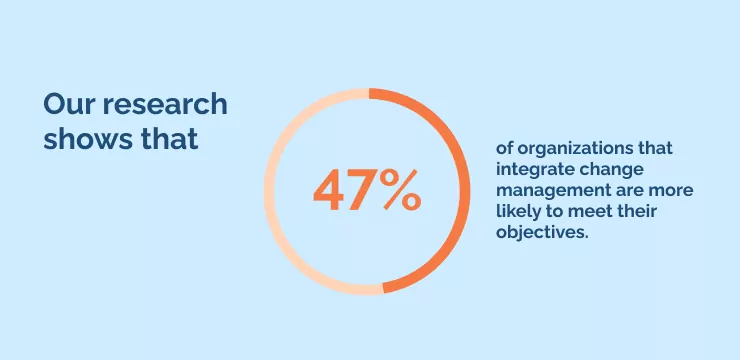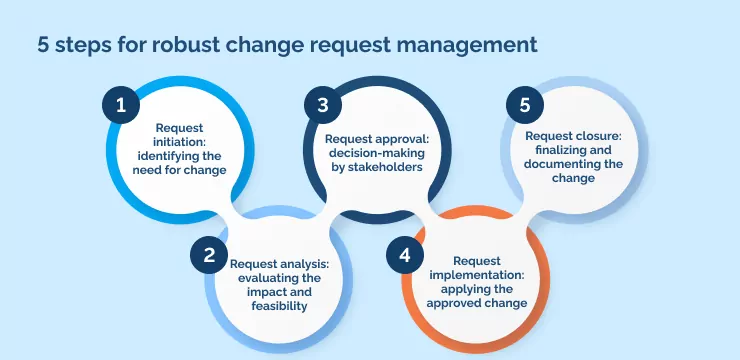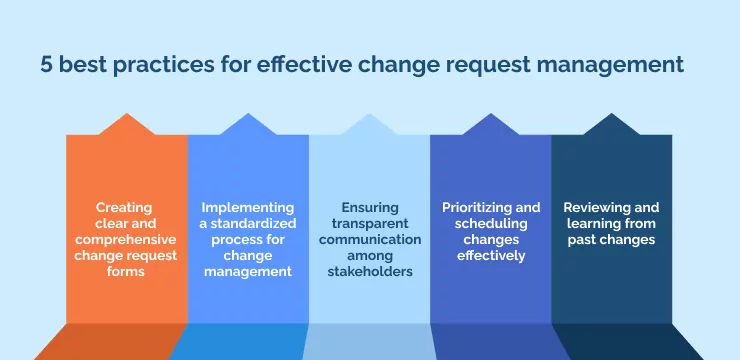
Having a plan for handling change requests is an important part of an overall robust change management strategy.
Change request management is the art of identifying, documenting, and resolving change requests. It’s important to have a change request management plan in place to ensure change requests are handled promptly, efficiently, and securely.
A change request addresses a specific need that was not part of the original project plan or makes adjustments based on new information.
Typically, change requests aim to introduce improvements, rectify problems, or adapt to evolving requirements.
They can involve alterations in scope, budget, resources, schedules, or any other aspect of a project or product.
Change requests, notably, are not incident requests. You don’t raise a change request in response to an issue arising or because something needs to be fixed.
It’s imperative you understand this difference. Incident request management is a process that’s typically owned by your IT department. Whereas change request management is owned by a change management team or a project management team.
In this article, we’re going to share everything you need to know to hit the ground running with change request management.
We’re going to dive into why change request management is so important, unravel common change request management frameworks, and break down the various organizational development roles that all contribute to creating a robust change request management process.
Understanding the importance of change request management

If there’s one thing that’s for certain in change management, it’s that nothing is for certain- you will come across scenarios where changes need to be made on the fly, often deviating from the original plan.
When this inevitably happens, having a plan for change request management helps you navigate the new situation.
This isn’t only something you should implement for the course of a single project- it can be beneficial to integrate change management best practices into the daily running of your business. Our research shows that 47% of organizations that integrate change management are more likely to meet their objectives.

On top of helping you navigate the change process more flexibly, good change request management also has the following benefits.
Maintains scope control
Managing change requests effectively prevents scope creep, which occurs when changes or additions to a project take place without proper control.
Scope creep can lead to budget overruns and delays, so it pays to stay on top of it.
Enhances communication
Change request management fosters communication among team members and stakeholders.
This helps you ensure that everyone is aware of what changes are being proposed, why they are necessary, and what impact they will have.
Facilitates resource allocation
Change request management helps you with resource allocation.
Knowing what changes are coming allows you to plan accordingly and ensure that resources are used effectively. It helps you make sure you have the right resources, in the right place, at the right time.
Reduces risks
By thoroughly evaluating the risks involved with a proposed change, change request management helps you make informed decisions.
This leads to reduced risks associated with hastily or poorly thought-out changes.
Increases stakeholder satisfaction
When managing change requests effectively, stakeholders are more likely to be satisfied with the result.
This is because their input has been considered, and the project is more likely to meet their needs and expectations.
Provides a learning opportunity
The process of managing change requests can provide valuable insights into what went well and what could have been done differently.
You can apply this learning to future projects, leading to continuous improvement.
Compliance and adaptability
In some cases, you may need to make changes to comply with legal or regulatory requirements.
Change request management ensures that your project remains compliant while adapting to new or updated regulations.
Ensures documentation and traceability
Keeping a record of what changes were made, why they were made, and what impact they had is vital for auditing and future reference.
This documentation is especially important in regulated industries where compliance with standards is mandatory.
5 steps for robust change request management

While there are many ways to approach change request management- and none of them are wrong- there are a few common threads between any approach.
We’ve distilled a breadth of change knowledge to produce these 5 steps, which we believe are the quintessential change request management process.
- Request initiation: identifying the need for change
At this stage, you identify a specific need for change within the project or product.
This could stem from a variety of sources, such as customer feedback, team suggestions, regulatory requirements, or market trends.
Clearly document the reason for the change, and submit a formal change request form that includes essential details like the proposed change, its rationale, and any supporting information.
- Request analysis: evaluating the impact and feasibility
Now, it’s time to thoroughly evaluate the proposed change.
Assess its impact on various aspects of the project, such as the budget, timeline, resources, and scope. Consider the feasibility by weighing the benefits against the costs and potential risks.
This step is critical for understanding if the change is worth implementing or if it could have negative repercussions.
- Request approval: decision-making by stakeholders
In this phase, present the change request and analysis to the stakeholders or decision-making authority.
They need to review the details and make an informed decision. The stakeholders might approve, reject, or request more information or modifications.
When stakeholders are involved in the decision-making process, it helps to ensure that the change aligns with the project’s objectives and has their support.
- Request implementation: applying the approved change
Once you get the green light, move forward with implementing the change.
Develop a detailed plan outlining the steps, resources, and timeline required to execute the change. Communicate the plan to all involved parties, ensuring that everyone knows their role.
Carefully monitor the implementation process to ensure that it stays on track and to quickly address any issues that may arise.
- Request closure: finalizing and documenting the change
After successfully implementing the change, it’s essential to formally close the change request.
Update the project documentation to reflect the implemented change and its impact. Communicate the completion of the change to all stakeholders, and gather feedback on the process and outcome.
Finally, document any lessons learned during the change request management process for future reference. This helps in improving the efficiency and effectiveness of managing changes in subsequent projects.
The roles of different teams in change request management
Change request management isn’t a one-man show.
It’s a cross-departmental practice that requires the input and buy-in of various teams to be truly effective.
Here’s a run-down of the key roles in an organization that play a major role in change request management:
Role of project managers
As a project manager, you play a pivotal role in change request management.
You are often the first point of contact for initiating change requests. It’s your responsibility to ensure that the team properly documents each change request.
Additionally, you assess the potential impacts and feasibility of the proposed change. You also present the change request to stakeholders and decision-makers.
Once a change is approved, you oversee its implementation, ensuring that the team allocates resources efficiently and adheres to the schedule.
Throughout the process, effective communication with all parties involved is critical.
Role of quality assurance teams
If you’re part of a quality assurance team, your role in change request management is to ensure that the proposed change maintains or enhances the project’s or product’s quality.
You must review the change request to understand its implications on quality parameters. During implementation, you must rigorously test the changes to ensure they meet the predefined quality standards.
Finally, provide feedback and suggestions for improvement, and document the quality assessment results.
Role of development teams
As a development team member, your role is instrumental in implementing the approved change.
You need to understand the specifications of the change request and how it impacts the current development process. Collaborate with the project manager to develop an implementation plan. Make the necessary modifications to the code or product, adhering to best practices.
Throughout the development phase, maintain open lines of communication with the quality assurance teams and the project manager, updating them on progress and any issues that arise.
Role of stakeholders
As a stakeholder, you are essential in the change request management process, particularly during decision-making.
You need to evaluate the change request from a strategic perspective, considering the goals and objectives of the project or organization. Your insights and decisions can shape the direction of the change.
After the implementation of the change, provide feedback on the results and participate in lessons-learned sessions to contribute to the continuous improvement of the change request management process.
5 best practices for effective change request management

Change request management can pose a number of challenges.
You’ll often face the hurdle of organizational resistance, as people tend to be wary of changes to established processes or goals.
Additionally, maintaining quality is a challenge, as changes can sometimes lead to unintended consequences or lower standards.
On top of that, you have to strike a balance between speed and thoroughness; moving too quickly can result in mistakes, while being too cautious may cause delays and missed opportunities.
To help you overcome these challenges, we advise that you follow these 5 best practices for change request management:
Creating clear and comprehensive change request forms
Start by creating a clear and comprehensive change request form.
This form should capture all the essential information about the proposed change, such as its description, rationale, impact, and any supporting documents.
A well-structured form helps ensure that everyone involved clearly understands what the change entails and why it is needed.
Implementing a standardized process for change management
Establish and implement a standardized process for managing change requests.
A consistent process ensures that all changes are evaluated, implemented, and documented systematically.
This brings efficiency and helps maintain quality and ensures that nothing slips through the cracks.
Ensuring transparent communication among stakeholders
Ensure that there is transparent communication among all stakeholders involved in the change request.
Keep everyone informed about the status of the change request, the decisions made, and the progress during implementation.
Transparent communication helps build trust and ensures that all stakeholders are on the same page.
Prioritizing and scheduling changes effectively
It’s important to prioritize and schedule changes effectively.
Evaluate the urgency and importance of each change request and prioritize them accordingly. Develop a schedule that outlines when and how the changes will be implemented.
This helps ensure that critical changes are addressed promptly and resources are allocated efficiently.
Reviewing and learning from past changes
After the implementation of a change, take the time to review how the process went and what the results were.
Gather feedback from team members and stakeholders. Analyze what went well and what could have been done differently. Document and use these insights to improve the change request management process for future projects.
This practice of continuous learning is essential for improving efficiency and effectiveness over time.
Don’t let your project become just another failure statistic
Did you know that only 34% of change initiatives succeed?
It’s a startlingly low number, and if you don’t want your projects to join the failing majority of change initiatives, you need to ensure you take change request management seriously.
Change request management is a procedural necessity and a strategic enabler that can drive your business toward success.
As business landscapes continue to evolve, you need to keep abreast of the latest trends and best practices in change request management.
Take proactive steps to enhance your change management process, leverage technology, and foster a culture that embraces change. Encourage continuous learning and improvement within your organization to ensure you are well-equipped to navigate the changes.
That’s how you drive your organization forward in an ever-changing world.
WalkMe Team
WalkMe spearheaded the Digital Adoption Platform (DAP) for associations to use the maximum capacity of their advanced resources. Utilizing man-made consciousness, AI, and context-oriented direction, WalkMe adds a powerful UI layer to raise the computerized proficiency, everything being equal.



